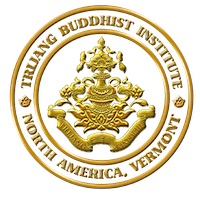Former incarnations of Kyabje Trijang Dorje Chang
Indian Masters:
Buddhapalita (470–550 ce) was one of the masters who clarified the Madhyamika Prasangika (the Middle Way) philosophical system. Among his best-known works are his commentaries to the Mulamadhyamaka of the great Nagarjuna, who explained the meaning of more than a hundred reasonings that Chandrakirti and then Je Tsongkhapa would take up at a later date.
Dignāga (sixth century ce) was a disciple of Vasubandhu. Using reasonings as the base, he founded the branch of the Cittamatra or Mind Only school.
Candrakīrti (c. 600-650 ce) was, after Nagarjuna, the greatest Madhyamaka philosopher; he was a monk at the renowned Nalanda Monastic University in India and developed the Madhyamaka Prasangika system of philosophy.
Śāntarakṣita (eighth century) was a Bengali of princely origin. He founded the Yogacara Svatantrika-Madhyamaka system. He was invited to Tibet by King Trisong Detsen and there played a decisive role. He founded Samye Monastery, modeled after the Monastic University of Odantapuri in India. It was he who ordained the first Tibetan monks and organized the Tibetan monastic system following the Vinaya (monastic discipine).
Atiśa Dīpaṃkāra Śrījñāna (980–1054) was a Bengali of princely origin. He was Abbot of the Monastic University of Vikramaśīla. Almost a century after Śāntarakṣita, he too was invited to Tibet, where he played a key role, sparking the renewal of Buddhism’s second dissemination there. In Tibet he corrected many erroneous practices such as separating the practices of Sutra and Tantra. He also wrote a large number of works, the best known of which is the Bodhipathapradipam or Light on the Path to Enlightenment (Tib: byang chub lam gyi sgron ma). He was famous for his extraordinary spiritual accomplishments, including the precious mind of bodhicitta, which he achieved under the guidance of his master Suvarnadvipa Guru or in Tibetan Lama Serlingpa. This master’s kindness and teachings shine even today. The spiritual practices at the heart of the four Tibetan Buddhist schools—Nyingma, Sakya, Kagyu, and Gelug—continue to be based on his precious teachings.
Tibetan Masters
Ra Lotsawa Dorje Drag (twelfth century), one of the greatest Tibetan translators of Buddhist works written from Sanskrit.
Geshe Lang-ri Thangpa Dorje Senge (1054–1123) was a Kadampa master who spread the teaching and practice known as “lojong,” which in Tibetan means “mind training.” Among others works, he wrote Mind Training in Eight Verses (Tib: blo sbyong tshig brgyad ma)
Eighth Karmapa Mikyö Dorje (1507–1554) was head of the Karma Kagyu school. He was a very great master, famous as much for his erudition as for his practice.
Zurchen Chöying Rangdröl (1604–1669) was a Nyingmapa master, and one of the Fifth Dalai Lama Ngawang Lobsang Gyatso’s masters.
Masters of the Gelugpa School
Tri Mönlam Pelwa (1414–1491) was the eighth Ganden Tripa, that is, Je Tsongkhapa’s successor and supreme head of the Gelugpa school.
Tri Jangchub Chöpel (1756–1838), was the sixty-ninth Ganden Tripa and the first master who went by the name of “Trijang”, combining the syllables “Tri” and “Jang” from Jangchub.
Tri Lobsang Tsultrim Palden (1838–1900), eighty-fifth Ganden Tripa, second Trijang Rinpoche.
Sources: Memoirs of H. H. Kyabje Trijang Rinpoche, Gashar, 2000.
This short biography of Kyabje Trijang Dorje Chang, composed in French by Ani Marie-Stella Boussemart, His Eminence Dagpo Rinpoche’s French translator, is drawn from the original Tibetan autobiography of the late Kyabje Trijang Dorje Chang. It has been translated into English and edited with respectful devotion as a Losar offering for our most precious, incomparable, and beloved Lama Kyabje Trijang Chocktrul Rinpoche. May all beings enjoy supreme compassionate bliss. Sarva Mangalam.
February 25, 2009
Losar 2136 Female Earth Ox year
